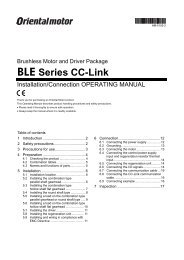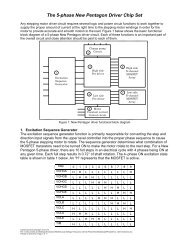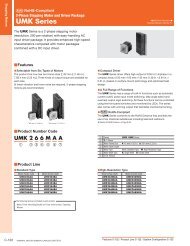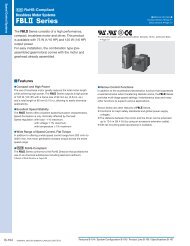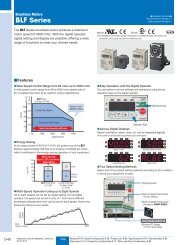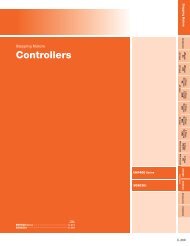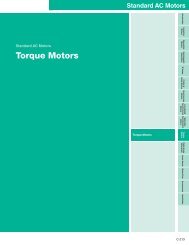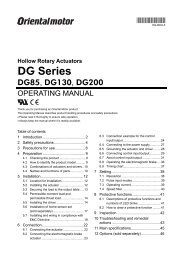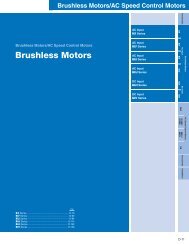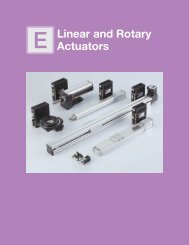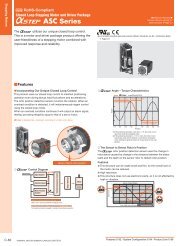Product Reference - Oriental Motor
Product Reference - Oriental Motor
Product Reference - Oriental Motor
You also want an ePaper? Increase the reach of your titles
YUMPU automatically turns print PDFs into web optimized ePapers that Google loves.
Technical <strong>Reference</strong><br />
■Speed – Torque Characteristics of<br />
Induction <strong>Motor</strong>s<br />
The figure below shows the speed – torque characteristics of<br />
induction motors.<br />
Torque<br />
TM<br />
Unstable<br />
Region<br />
M<br />
Stable<br />
Region<br />
■Speed – Torque Characteristics of<br />
Reversible <strong>Motor</strong>s<br />
The reversible motor is a capacitor run, single-phase induction<br />
motor that features the same speed – torque characteristics as an<br />
induction motor, as described above. However, the reversible motor<br />
features a higher starting torque than an induction motor in order to<br />
improve the instant reversing characteristics.<br />
Torque<br />
Reversible <strong>Motor</strong><br />
TS<br />
TP<br />
R<br />
P<br />
Induction <strong>Motor</strong><br />
Speed<br />
Under no load, the motor rotates at a speed close to synchronous<br />
speed. As the load increases, the motor's speed drops to a level (P)<br />
where a balance is achieved between load and motor torque (Tp).<br />
If the load is further increased and reaches point M, the motor can<br />
generate no greater torque and stops at point R.<br />
In other words, the motor can be operated in a stable range between<br />
M and O, while the range between R and M is subject to instability.<br />
Induction motors are available in two types: single-phase (capacitor<br />
run) and three-phase induction motors. With the single-phase motor,<br />
the starting torque is generally smaller than the operating torque,<br />
while the three-phase motor features a relatively greater starting<br />
torque.<br />
Torque<br />
Torque<br />
O<br />
Speed<br />
■Speed – Torque Characteristics of<br />
Torque <strong>Motor</strong>s<br />
The figure below shows the speed – torque characteristics of torque<br />
motors.<br />
The speed – torque characteristics of torque motors differ from those<br />
of induction motors or reversible motors. As the graph shows, they<br />
have sloping characteristics (torque is highest at zero speed and<br />
decreases steadily with increasing speed), enabling stable operation<br />
over a wide speed range, from starting to no load speed. The torque<br />
generated during reversal of the motor is a large positive torque in<br />
the same direction as the rotational magnetic field. When the motor<br />
which rotates uni-directionally is locked by the load and the motor<br />
is rotated opposite the desired direction, this torque acts as a force<br />
(braking force) to inhibit the motor from rotating backwards.<br />
Torque<br />
Stable Region<br />
Braking Region<br />
Stable Region<br />
of Induction<br />
<strong>Motor</strong><br />
Speed<br />
Single-Phase Induction <strong>Motor</strong>s<br />
Speed<br />
Three-Phase Induction <strong>Motor</strong>s<br />
Torque <strong>Motor</strong><br />
The torque the motor produces changes proportionally to roughly<br />
twice the power supply voltage.<br />
For example, if 110 V is applied to a motor whose rated voltage is<br />
100 V, the torque produced by the motor increases to approximately<br />
120%. In this case, the motor temperature will rise and may exceed<br />
the permissible range.<br />
If 90 V is applied to the same motor, the torque produced by the<br />
motor decreases to approximately 80%. In this case, the motor may<br />
not be able to operate the automated equipment as expected.<br />
For the above reasons, the power supply voltage should be kept<br />
within ±10% of the rated voltage. Otherwise, when the power<br />
supply voltage fluctuates beyond the aforementioned range, the<br />
motor temperature may rise beyond the permissible range or the<br />
motor torque may drop and thereby make the equipment operation<br />
unstable.<br />
−Ns<br />
Induction <strong>Motor</strong><br />
0<br />
Speed<br />
■Temperature Rise in Standard AC <strong>Motor</strong>s<br />
●Temperature Rise in <strong>Motor</strong>s<br />
When a motor is operating, all energy loss (copper loss, iron loss,<br />
etc.) of the motor is transformed into heat, causing the motor's<br />
temperature to rise.<br />
· Induction motors (continuous rating) reach the saturation point of<br />
temperature rise after two or three hours of operation, whereupon<br />
its temperature stabilizes.<br />
· Reversible motors (30 minutes rating) reach their limit for<br />
temperature rise after 30 minutes of operation. The temperature will<br />
increase further if operation continues.<br />
Ns<br />
F-36 ORIENTAL MOTOR GENERAL CATALOG 2009/2010



